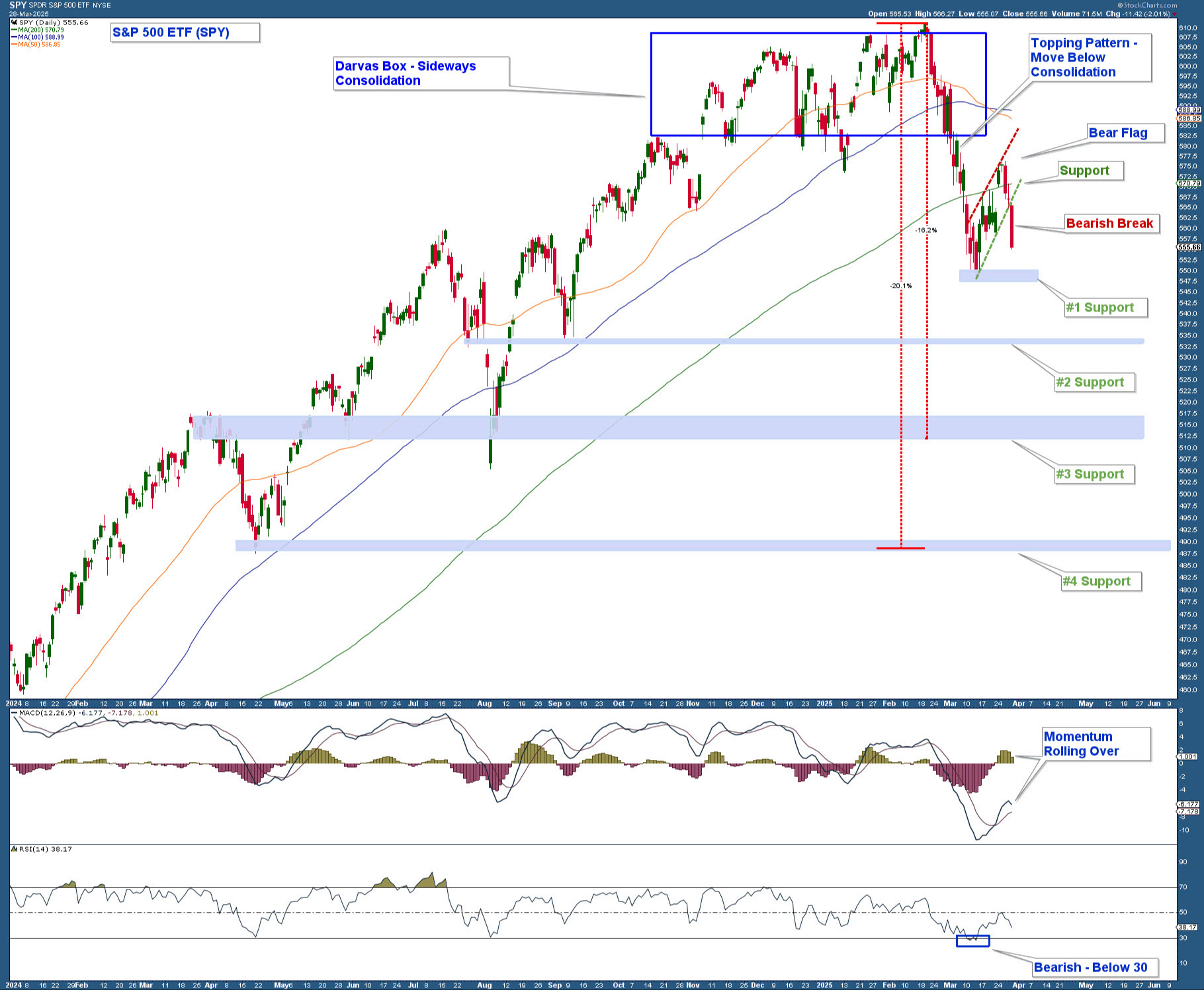The market has shifted decisively over the past month. After spending several months in a narrow trading range, the S&P 500 has broken lower with increasing momentum, signaling a possible transition from a consolidation phase into a more meaningful correction.
While this environment presents challenges, it also offers an important advantage for disciplined investors: those who protect their capital during this decline will be in a strong position to re-enter the market at more favorable prices when conditions improve.
In this month’s newsletter, we focus on one chart—the S&P 500 ETF (SPY)—which captures the recent breakdown and the growing risk of further downside. Several key technical developments are outlined below.
SPY: Breakdown from Bear Flag and What Comes Next
SPY had been in a steady uptrend through early 2025, but that trend stalled in February after a brief breakout above the top of a four-month Darvas Box (NYSE:BOX). That move quickly reversed, and the index fell over 10% by mid-March in a straight-line decline—a sign of broad selling pressure and little interest in buying the dip.
The market then attempted a modest recovery, forming a bear flag pattern, but that bounce has now failed. This past Friday, SPY dropped nearly 2% and broke decisively below the lower edge of that flag, confirming a continuation of the downtrend.
Despite the breakdown, the index has not yet taken out the recent lows that preceded the bear flag. That level—labeled #1 Support on the chart—is about 1% below the current price. Based on the current technical picture, the odds of this level holding appear low:
The MACD is sitting well below zero and is starting to roll over, reflecting strong downside momentum.
The RSI fell below 30 during the initial leg down, which typically doesn't happen during shallow corrections in bull markets. This is a sign of a more forceful bearish shift.
One of the more concerning developments is the weakness in key risk-on sectors. Both Technology (XLK) and Semiconductors (SOXX)—which often lead during healthy market advances—have already broken below their March lows. This breakdown signals a loss of leadership and adds to the growing evidence that investors are shifting away from risk, reinforcing the current risk-off tone.
The chart highlights several support levels to watch:
#1 Support: immediate short-term support, ~1% below current prices.
#2 Support: 3.8% below the current level.
#3 Support: 16% below the February peak.
#4 Support: 20% below the peak, a level that would mark an official bear market.
Given the bearish flag pattern break, deteriorating momentum, ongoing sector rotation into defensive areas, and continued poor breadth, the path of least resistance now appears to be lower. A breakdown through #1 and #2 Support is likely and would clear the way for a deeper decline toward #3 or even #4 Support.
In this type of environment, preserving capital becomes the priority. The deeper the decline, the greater the opportunity for disciplined investors to step in at far better prices—with more capital intact to take advantage of those opportunities when conditions turn positive.
Current Account Update
As noted in last month’s newsletter, I quickly removed client accounts from equities once the market began to break down. As a result, we’ve largely avoided the damage from the recent move lower. This defensive positioning has helped preserve capital during a period of rising volatility and deteriorating technical conditions.
Looking ahead, this positions us well for what could be a significant opportunity. If the market continues to decline, we will have the ability to re-enter at much lower prices with most of our capital intact—an advantage that can make a meaningful difference in long-term performance. Until the technical picture improves, I’ll prioritize capital preservation while looking for the right time to shift back into equities.
Which stock should you buy in your very next trade?
With valuations skyrocketing in 2024, many investors are uneasy putting more money into stocks. Unsure where to invest next? Get access to our proven portfolios and discover high-potential opportunities.
In 2024 alone, ProPicks AI identified 2 stocks that surged over 150%, 4 additional stocks that leaped over 30%, and 3 more that climbed over 25%. That's an impressive track record.
With portfolios tailored for Dow stocks, S&P stocks, Tech stocks, and Mid Cap stocks, you can explore various wealth-building strategies.
